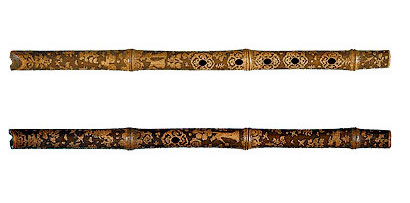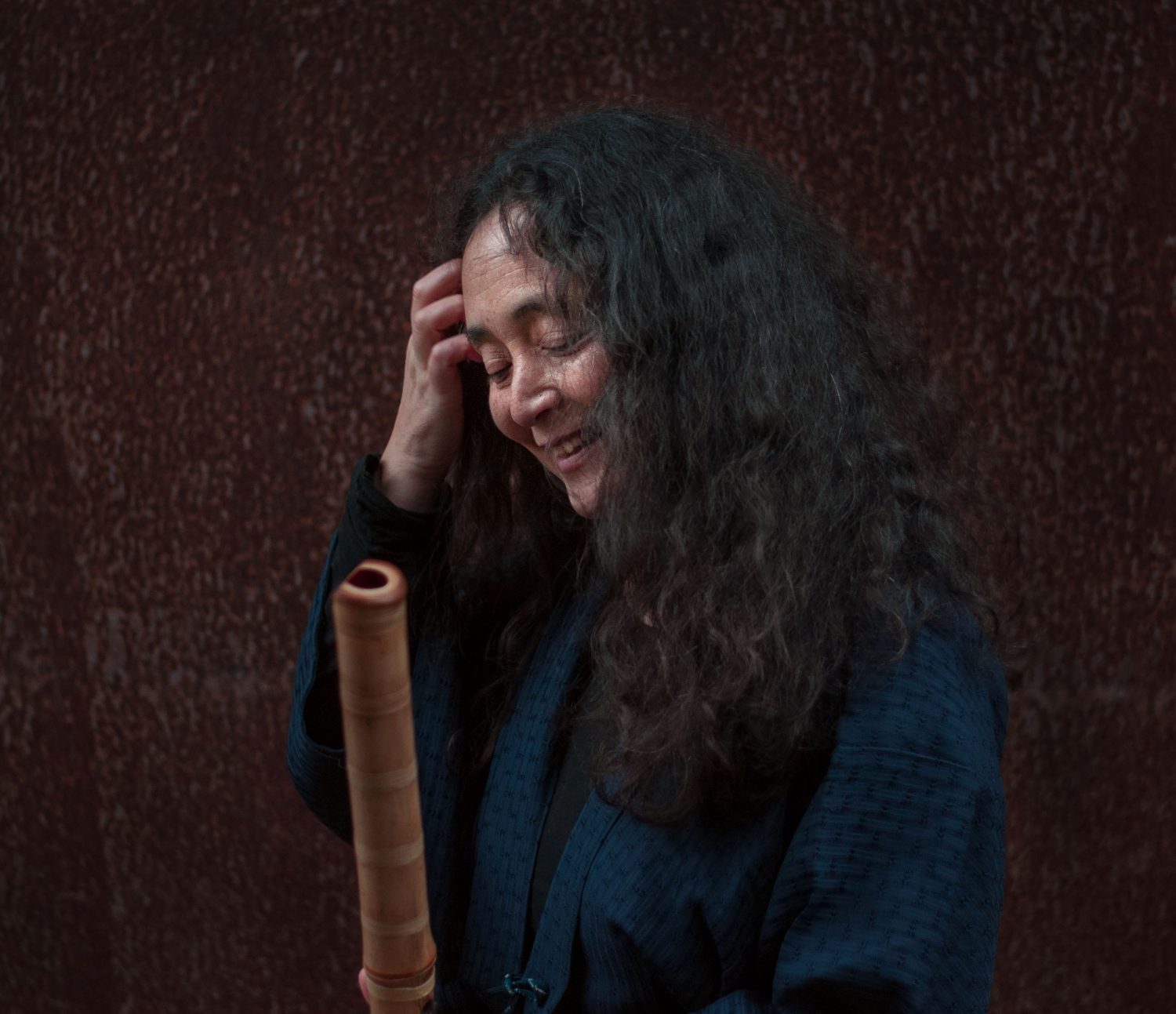The name shakuhachi refers to the standard length of the instrument in traditional measuring units, 1 shaku, 8 (hachi) sun which is 1.8 Japanese feet or 54.5 centimeters (D) although flutes of various lengths are played, most commonly 1.6, 1.8, 2.0, 2.4. The shakuhachihas five finger holes, four in the front and one thumbhole – although variations with 7 and 9 finger holes invented during the 20th century exist. It is tuned to an anhemitonic pentatonic scale and on the standard D instrument the notes are D F G A C. Despite that shakuhachi honkyoku is never pentatonic.

(Reproduced by the courtesy of Gekkai Bunko ̄, Hosshinji Temple)
According to organology (the science of musical instruments and their classification) the shakuhachiis a Japanese vertical notched oblique bamboo flute and has the classification number 421.111.12 in Hornbostel-Sachs (the classification system of the world’s musical instruments most frequently used today). This includes the variations jinashi shakuhachi, jiari/jinuri shakuhachi and the variations called kyotaku or Hotchiku.
Musical instruments are solidly embedded in local music cultures, and the shakuhachiis no exception. After the shakuhachiarrived in Japan in the 8th century with the gagaku ensemble from China via the Korea Peninsula, it went through a Japaniesation process whereby the material used to create the instrument changed to madake (Phyllostachys bambusoides), the most common bamboo in Japan. Out of the eight shakuhachi in the Shōsōin repository, three were made from ivory, stone and jade. The remaining five were made from a smaller type of Chinese bamboo

When the gagaku ensemble was reorganized in the mid-ninth century, the shakuhachi fell into disuse. A period of several centuries ensued in which no references to the instrument appear in surviving historical documents.
The first mention of the instrument after this hiatus appears in 1233 in the
Kyōkunshō, a ten-volume treatise on gagaku written by Koma Nochika-
zane: ‘The short flute is called shakuhachi. It is now played by mekurahōshi (blind monks) and performers of sarugaku (theatre)’. The first known illustration of a shakuhachi is found in the Taigenshō (1512) although the illustration is dated to the late fourteenth century. The shakuhachi is then called hitoyogiri,or ‘one node shakuhachi’.
During the early seventeenth century, the shakuhachi-playing monks organised themselves within a setting under the Fukeshū or Fuke sect, a sect loosely connected to Zen Buddhism. The monks of the Fuke sect were termed komusō or ‘priests of nothingness’. The first decree, Keichō no Okitegaki, that granted the komusō special privileges was enacted in 1614 by the first Tokugawa Shōgun, Tokugawa Ieyasu (1543–1616), . This served as the legal basis for the establishment of the Fuke sect, which only admitted men of the samurai class and rōnin (unemployed samurai) as members of the order. The special privileges granted the komusō included monopoly rights over the use of the shakuhachi (laymen were officially prohibited from playing the shakuhachi – a rule implemented in 1677) and travel passes that allowed them to travel to any part of Japan. According to the rules of the sect the shakuhachi was to be used exclusively as a hōki, a sacred tool, for the purpose of spiritual training and for takuhatsu (religious mendicancy). However, it is known that some komusō did not obey these rules and even opened shakuhachi teaching schools in for example Edo (present day Tokyo).
In all, Nakatsuka Chikuzen lists seventy-seven Fuke temples that were scattered around Japan during the Edo period. Three of the most important Fuke temples during this period were Myōanji in Kyoto and Ichigetsuji and Reihōji in the Kanto region, the area around Edo or present day Tokyo. Each temple developed its own corpus of music which, when taken together, comprise the repertoire of approximately 150 honkyoku (original or fundamental pieces) from the Edo period known today. Honkyoku is a term that refers to the solo pieces played by komusō monks, that has its roots in the Edo period and was used for either their spiritual training or religious mendicancy. Interaction among the temples, including musical exchange, took place by means of komusō monks who wandered from temple to temple. Music other than honkyoku was referred to as gaikyoku (outer pieces) or rankyoku (disorderly pieces). The relationship between the bakufu (the Edo government) and the Fuke sect worsened due to difficulties controlling the sect and criminal behaviour on the part of some monks. In 1847 a decree from the government stated that the Fuke sect had to abide by the same rules as the Rinzai sect. This revoked the special privileges granted in Kenchō no Okitegaki, which led to frustration among the komusō monks. The deterioration in the relationship culminated when the thirty-third kansu of Myōanji, Gendō Kanmyō and Myōan Sugyō, also from Myōanji ,were involved in the ‘Hamaguri Gomon Rebellion’ in 1864 as advocates for Imperial rule against the Tokugawa Shogunate. Mutual distrust increased and the number of sanctions and investigations of komusō monks increased.
The Edo bakufu was overthrown in 1868 and in October 1871, the new Meiji government (1868–1912) issued a decree Dajōkan Fukoku, which, among other things abolished the Fuke sect indefinitely. Begging was prohibited in 1872, although it was again made legal in 1881. These events, along with the Meiji Government’s decision to prioritise Western music in compulsory education, naturally had a strong impact on the shakuhachi, its music and environment and led to major changes. According to Tsukitani Tsuneko and Shimura Satoshi, the shakuhachi was to follow two distinct paths from the abolition of the Fuke sect: secular and religious.
